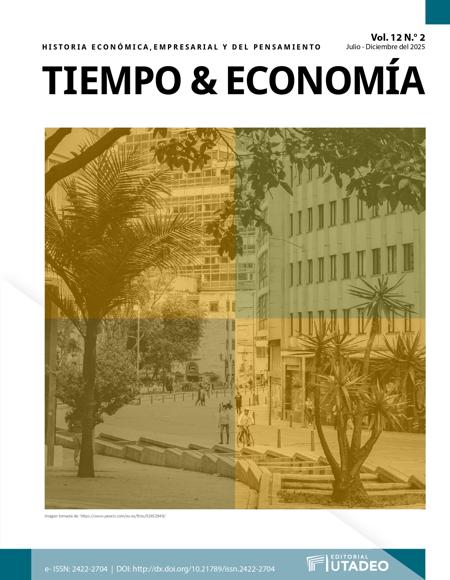
Esta obra está bajo una licencia internacional Creative Commons Atribución-NoComercial-CompartirIgual 4.0.
Esta obra está bajo una licencia internacional Creative Commons Atribución-NoComercial-CompartirIgual 4.0.
Resumen
This study examines the complex relationships among information and communication technology (ICT), air transport, freshwater resources, economic growth, and migration patterns in different regions of the world from 2000 to 2022. Drawing on data from the World Bank, the study employs Jamovi software for descriptive statistics, correlation analysis, and regression, complemented by ANOVA techniques to assess the significance of the differences across regions. Regions such as East Asia and the Pacific show robust economic benefits from high levels of ICT adoption and extensive air connectivity, which are positively correlated with GDP growth and trade in services. In contrast, regions such as Sub-Saharan Africa and South Asia exhibit significantly lower levels of ICT adoption and air transport efficiency, contributing to the challenges in their economies and to their increasing out-migration rates. The study also reveals that increased Internet use is driving economic growth, while access to freshwater resources has emerged as a critical determinant of both economic health and migration strategies. Notably, the study finds that areas with better freshwater management policies are better positioned to mitigate migration pressures caused by economic instability. The implications of these findings underscore the need for policymakers to adopt a holistic approach that integrates ICT development, transportation infrastructure improvements, and sustainable water management to stimulate economic growth and mitigate migration pressures. Recommendations to policymakers include targeted investments in ICT and transport systems, as well as policies aimed at improving local economic opportunities. In addition, future research should explore the qualitative factors influencing these relationships and expand the geographic scope to better understand the dynamics at play. This study contributes to the existing literature on the subject by elucidating the interconnectedness of these critical factors and providing insights for effective regional development strategies.
Citas
Akanbi, O. A. (2017). Impact of migration on economic growth and human development: Case of Sub-Saharan African countries. International Journal of Social Economics, 44(5), 683-695. https://doi.org/10.1108/IJSE-07-2015-0190
Appiah-Otoo, I., & Song, N. (2021). The impact of ICT on economic growth-Comparing rich and poor countries. Telecommunications Policy, 45(2), 102082. https://doi.org/10.1016/j.telpol.2020.102082
Arora, H. K. (2014). International Migration: Trends and Economic Benefits. International Journal of Business & Economics Perspectives, 9(1).
Awad, A., & Albaity, M. (2022). ICT and economic growth in Sub-Saharan Africa: Transmission channels and effects. Telecommunications Policy, 46(8), 102381. https://doi.org/10.1016/j.telpol.2022.102381
Balsalobre-Lorente, D., Driha, O. M., Bekun, F. V., & Adedoyin, F. F. (2021). The asymmetric impact of air transport on economic growth in Spain: fresh evidence from the tourism-led growth hypothesis. Current issues in tourism, 24(4), 503-519. https://doi.org/10.1080/13683500.2020.1720624
Baltaci, N., Sekmen, O., & Akbulut, G. (2015). The relationship between air transport and economic growth in turkey: Cross-regional panel data analysis approach. Journal of Economics and Behavioral Studies, 7(1 (J)), 89-100. https://doi.org/10.22610/jebs.v7i1(J).566
Duval, D. T. (2013). Critical issues in air transport and tourism. Tourism geographies, 15(3), 494-510. https://www.tandfonline.com/doi/abs/10.1080/14616688.2012.675581
Fernández-Portillo, A., Almodóvar-González, M., & Hernández-Mogollón, R. (2020). Impact of ICT development on economic growth. A study of OECD European union countries. Technology in Society, 63, 101420. https://doi.org/10.1016/j.techsoc.2020.101420
Keček, D., Boljunčić, V., & Milković, M. (2019). Effects of final expenditures on ICT goods and services on the Croatian domestic output and imports–the input-output approach. Economic research-Ekonomska istraživanja, 32(1), 531-544. https://doi.org/10.1080/1331677X.2018.1556109
Kundzewicz, Z. W. (2007). Global freshwater resources for sustainable development. Ecohydrology & Hydrobiology, 7(2), 125-134. https://doi.org/10.1016/S1642-3593(07)70178-7
Łukaniszyn-Domaszewska, K., Mazur-Włodarczyk, K., & Łukaniszyn, M. (2025). Unveiling the Interrelations Between Migration, Climate Change, and Energy Transitions in the Context of Socioeconomic Disparities. Energies, 18(7), 1625. https://doi.org/10.3390/en18071625
Luong, T. A., & Nguyen, T. H. (2021). The impact of ICT on service trade. The Singapore Economic Review, 66(04), 1073-1086. https://doi.org/10.1142/S021759082049003X
Nath, H. K., & Liu, L. (2017). Information and communications technology (ICT) and services trade. Information Economics and Policy, 41, 81-87. https://doi.org/10.1016/j.infoecopol.2017.06.003
Nchake, M. A., & Shuaibu, M. (2022). Investment in ICT infrastructure and inclusive growth in Africa. Scientific African, 17, e01293. https://doi.org/10.1016/j.sciaf.2022.e01293
Nechifor-Vostinaru, V. (2018). Modelling freshwater resources use and the economic impacts of demand-driven water scarcity (Doctoral dissertation, UCL (University College London)).
Nguyen, C. V. (2024). Air Transport Resilience, Tourism and Its Impact on Economic Growth. Economies, 12(9), 236. https://doi.org/10.3390/economies12090236
Onifade, S. T., Gyamfi, B. A., Bekun, F. V., & Altuntaş, M. (2022). Significance of air transport to tourism-induced growth hypothesis in E7 economies: exploring the implications for environmental quality. Tourism: An International Interdisciplinary Journal, 70(3), 339-353. https://doi.org/10.37741/t.70.3.1
Podra, O., Levkiv, H., Koval, G., Petryshyn, N., & Bobko, U. (2020). The impact of migration processes on the economy of Ukraine: Trends, reasons, consequences. Journal of the Geographical Institute “Jovan Cvijic”, SASA, 70(2), 171-179. https://doi.org/10.2298/IJGI2002171P
Pradhan, R. P., Arvin, M. B., & Nair, M. (2021). Urbanization, transportation infrastructure, ICT, and economic growth: A temporal causal analysis. Cities, 115, 103213. https://doi.org/10.1016/j.cities.2021.103213
Rahman, H. U., Ali, G., Zaman, U., & Pugnetti, C. (2021). Role of ICT investment and diffusion in the economic growth: a threshold approach for the empirical evidence from Pakistan. International Journal of Financial Studies, 9(1), 14. https://doi.org/10.3390/ijfs9010014
Raicu, S., Costescu, D., Popa, M., & Dragu, V. (2021). Dynamic intercorrelations between transport/traffic infrastructures and territorial systems: From economic growth to sustainable development. Sustainability, 13(21), 11951. https://doi.org/10.3390/su132111951
Raihan, A., Muhtasim, D. A., Pavel, M. I., Faruk, O., & Rahman, M. (2022). Dynamic impacts of economic growth, renewable energy use, urbanization, and tourism on carbon dioxide emissions in Argentina. Environmental Processes, 9(2), 38. https://doi.org/10.1007/s40710-022-00590-y
Rani, S. (2025). Land and Water Nexus: Exploring the Interplay of Resources in South Asia: An Introduction. In Land and Water Nexus in South Asia (pp. 1-48). Springer, Cham. https://doi.org/10.1007/978-3-031-87429-1_1
Rayevnyeva, O., Stryzhychenko, K., & Matúšová, S. (2023). Impact of Migration Processes on GDP. Engineering Proceedings, 39(1), 86. https://doi.org/10.3390/engproc2023039086
Rock, M. T. (1998). Freshwater use, freshwater scarcity, and socioeconomic development. The Journal of Environment & Development, 7(3), 278-301. https://doi.org/10.1177/107049659800700304
Shodiev, T., Turayey, B., & Shodiyev, K. (2021). ICT and economic growth nexus: Case of central Asian countries. Procedia of Social Sciences and Humanities, 1, 155-167. https://doi.org/10.21070/pssh.v1i.37
Tee, B. A., Tham, S. Y., & Kam, A. J. Y. (2020). The role of ICT in ASEAN-5’s services exports: A panel study. Malaysian Journal of Economic Studies, 57(1), 1-19. https://doi.org/10.22452/MJES.vol57no1.1
Wilson, M. A., & Carpenter, S. R. (1999). Economic valuation of freshwater ecosystem services in the United States: 1971–1997. Ecological applications, 9(3), 772-783. https://doi.org/10.1890/1051-0761(1999)009[0772:EVOFES]2.0.CO;2
Yao, S., & Yang, X. (2012). Air transport and regional economic growth in China. Asia-Pacific Journal of Accounting & Economics, 19(3), 318-329. https://doi.org/10.1080/16081625.2012.667458
Yarde, K., & Zhang, C. (2024). Socio-economic Impact of Air Connectivity. In Strategies for Sustainable Air Services Development (pp. 23-44). Routledge. https://doi.org/10.4324/9780429260681-2
Zhang, F., & Graham, D. J. (2020). Air transport and economic growth: a review of the impact mechanism and causal relationships. Transport Reviews, 40(4), 506-528. https://doi.org/10.1080/01441647.2020.1738587

 PDF (English)
PDF (English)
 FLIP
FLIP












